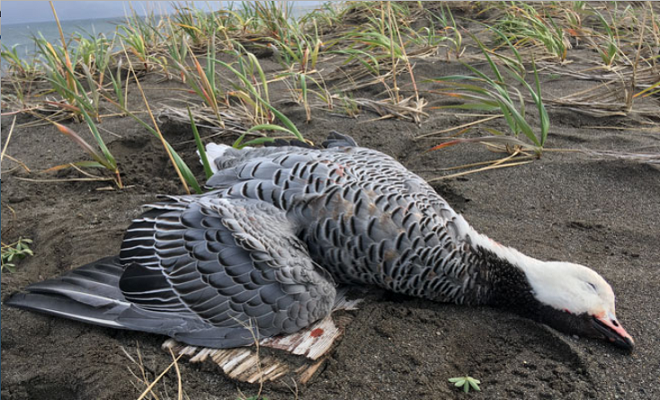
© Hugh Clark
Story & Photos by Hugh Clark
President of Alaska Waterfowl Association in Anchorage.
It was September in Alaska and waterfowl season was in full swing, those days that every serious waterfowler anticipates. The cool crisp mornings, the fall colors changing the landscape, and whistling wings above are just a few of the signs that reminds us it’s that time of year for wet and muddy dogs, waders, decoys, and ducks. 2017 waterfowl season had begun!
Cold Bay, Alaska, was calling; we had already been gunning local birds for over a month and with cooler temps in the air, it was time for a change. Months of anticipation and multiple yearly invites was finally about to become reality. I was headed to the Aleutian Islands.
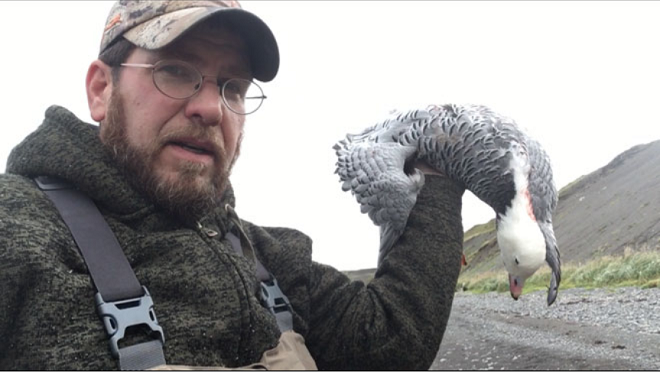
© Hugh Clark
Cold Bay is a lifelong dream for any waterfowler. For many, it’s the pinnacle of their waterfowl hunting life, similar to stepping foot on St. Paul Island in pursuit of the world-renowned king eider. In Cold Bay, record-book numbers of Pacific black brant feed on the largest eel grass beds in the world.
My journey was about to begin and if luck was on my side and my powder dry, my lifelong quest to get the North American Grand Slam was about to become closer to reality.
The Pacific black brant is an extremely popular and highly-prized specimen among waterfowlers around the world. Not only are they one of the finest regarding table fare, their simple presence within anyone’s home as a trophy depicts the true passion of that waterfowler’s life.
For me, it’s been a lifelong passion, from the rice fields of Texas, prairie lands across the Midwest to chasing black ducks on the Atlantic Flyway. Alaska harbors the last two species of this epic journey.
Now within 48 hours of arrival, I found myself lost in thought while asking myself many questions about what lay ahead as we boarded the plane headed to Cold Bay. Will this match the rush and emotional feelings that flowed through me the day I harvested my first long-tailed duck? Will it surpass it with an overwhelming desire to push forward? I’m not sure; the moment I reached down and those coal-colored feathers flowed through my fingers, I only hoped I could somehow be humbled and honored to have lived this waterfowler’s life.
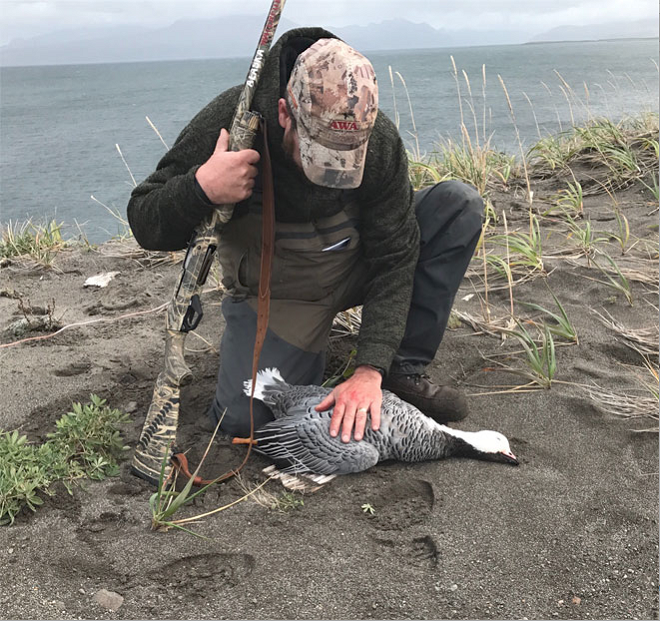
© Hugh Clark
The emperor goose is a magnificent species among the waterfowl of North America. Under a strict management plan for over 30 years, the Alaska Migratory Bird Co-Management Council worked closely with the Alaska Department of Fish and Game and many native organizations across the northwestern part of Alaska. Together they gathered nesting, population and migratory data, shared ideas, worked together and proposed a harvest plan for the fall of 2017. With numbers surpassing 170,000 birds and after 30 years of effective management principles and strict guidelines in place, native Alaskans and residents would once again be able to pursue this incredible bird.
This plan would allow the natives to once again teach the lost art of harvesting eggs and these magnificent birds with their children, allowing them to pass it on to the next generation. Only 1000 tags were allocated to be harvested between fall 2017 and the spring of 2018.
As I boarded the plane for Cold Bay I reached deep within trying to remember the first duck I harvested, where and why this desire to chase waterfowl began. The passion was deep and full of respect and conservation principles. I was nine, in the woods of the East Texas Trinity River bottoms, and these dark woods told many stories of cupped-up greenheads and whistling woodies cutting and dancing through the trees.
My dad was an avid waterfowler. He was standing close by sloshing his feet in the water imitating feeding birds while casting calls through an old P.S. Olt single reed. I’m sure that sound would stay with me forever as I sat there on that floating log. I will never forget that sound. There’s just something about the sound of a mallard hen echoing through the flooded timber. Unbeknownst to me, the whistling of over a dozen descending mallards were sliding down through the trees. My heart was pounding like any nine-year-old on Christmas morning. I kept looking at dad and waiting for direction, anything to indicate it’s time to move. Patiently I waited. “Now slowly stand Hugh, they’re going to be on your left, “ Dad told me. As I stood and raised my Sears and Roebuck 20-gauge single shot. I searched the sky hard, placed that BB at the end of the barrel on the first descending silhouette I could find.
I’m pretty sure I closed my eyes and pulled the trigger. The echoes of multiple guns sounding off across the flooded timber were quickly drowned out as I watched my bird fall lifeless to the water. A waterfowler was born.
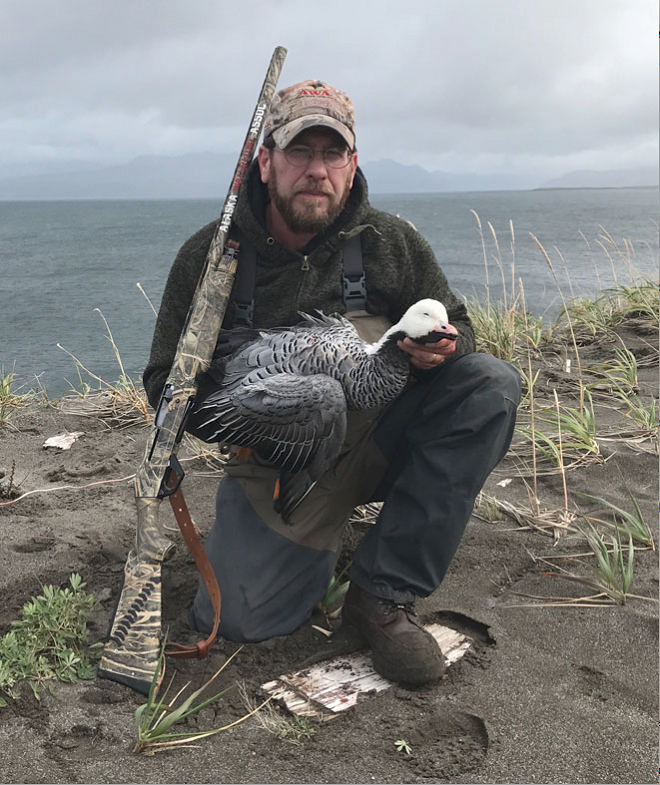
© Hugh Clark
My anticipation and level of expectation was through the roof as I checked in bags at Ted Stevens International Airport in Anchorage. The small talk from locals was everything from “I’ve been trying to get my bags home for a week,” to “With all the hunters in line I doubt any of them will see their bags upon arrival.”
Knowing our guns were labeled priority made me feel comfortable and smile, and that was good enough for me. Paying extra for overweight charges made us confident as we knew we had enough food to feed a dozen guys and clothing to outfit a small platoon; we were ready!
My carry pack was full, it contained my license, stamps, emperor goose tag, breathable waders, jacket, socks, fleece shirt, gloves and a Beanie hat. I was comfortable with that and the idea of begging, borrowing or bartering for ammo and boots if necessary to fulfill this once-in-a-lifetime hunt.
Forty years later and four days before my 50th birthday, I was feeling the same emotions as my former 9-year-old self. How was this still possible? I’ve hunted all over the United States, held many a “first” birds. This is is what it’s like to be a waterfowler. To never get tired of getting up at 2 a.m., guns, dogs, decoys and the dedication to fulfilling that inner pull and desire to see cupped-up birds while turning an ear to those whistling wings. Nothing is better; we are a special breed no doubt. We require good friends who share our passion and the same level of desire, we’re lucky if a good dog graces our presence and allows us the opportunity to earn the title as his master.
Years of anticipation had been bottled up, and the idea of holding a black brant was more than most waterfowlers could wrap their heads around. Forty years of chasing my feathered friends and the last goose to complete my slam was just a short two-hour flight ahead. Top that off with a long time protected and now hunt-able emperor goose, it just couldn’t get any better. Nothing’s better then three waterfowling friends linking up to explore the remote areas of Alaska while chasing exotic black brants, emperors and sub-species of Canadas.
Jon and I were good to go, dedicated and considered “diehards.” Tyler had over thirteen years of Cold Bay hunting experience and was a veteran of this rugged- and unforgiving terrain. He had just returned the week prior after spending five days harvesting brants, taveners, and cacklers along with his emperor goose. The stories and level of confidence were instrumental in letting us know this was going to happen.
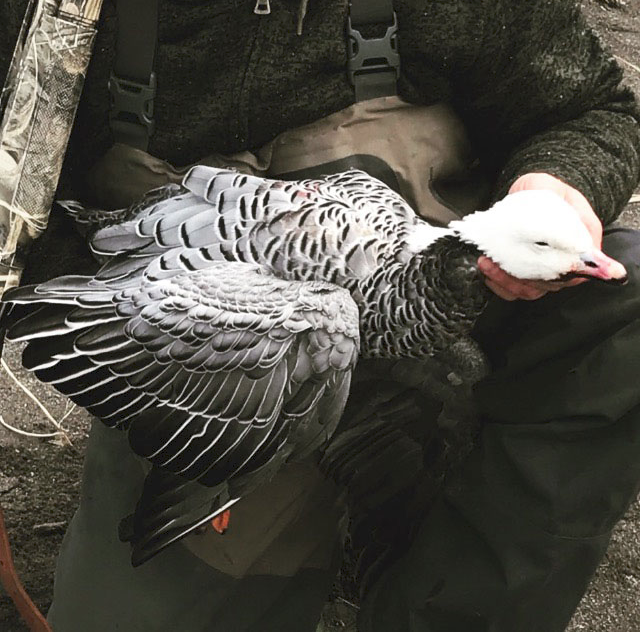
© Hugh Clark
It’s very rare going into a hunt knowing the outcome. Reality was, it was up to us and with some luck and a few stars lining up… we would hope for the best and take it all with a grain of salt.
A week earlier I had been approached by “Gordy” Chief Editor of Take-Em Waterfowl magazine. We briefly discussed the ideas around documenting this epic Alaska waterfowling adventure. The story behind the emperor’s conservation and management plan was one that needed to be told. A huge conservation success story and one most likely not known in the lower 48.
As we landed and stepped off the plane in Cold Bay, the cool crisp air was bellowing at 35 knots. Tyler looked at me and smiled. “Let’s go get checked in and hit the Lagoon. This wind is exactly what we need.” I couldn’t help but wonder if he was pulling my leg or honestly serious. Regardless, we were about to embark on an incredible Alaskan waterfowling adventure.
As we waited to retrieve our bags we soon realized the reality of traveling to remote and isolated areas within Alaska. Not one of our checked bags had arrived, our backpacks and guns were all that had made the short trip. We looked around and immediately realized this was going to be a rough few days in one of the most brutal and remote parts of Alaska. We hurried and filed the lost baggage forms, communicated our frustration with the carrier and rushed to the hotel across the street. From Tyler’s perspective there was always some “community” waders, boots, and clothing available. We managed to rummage through the left-over luggage from past waterfowlers and found some jackets and a couple of boxes of shells. We grabbed them and loaded up into the rental truck.
Having hunted all over remote Alaska, I was familiar with these hardships and had experienced them multiple times. We just had to get through today and hopefully our bags would arrive tomorrow. We embraced this opportunity, dug deep and hit the road with high expectations, not worrying about anything that had happened 10 minutes ago.
Tyler had seen a few flocks of emperors just the week prior. Knowing that geese are critters of habit, he expected them to be at one of the three previous locations. Fifteen minutes later I found myself peering through 30-knot winds over the Bering Sea. Huge volcanic mountains rising up out of the water, treeless and covered in bare tundra was a sight to remember. Below the horizon around 300 yards sat around fifty emperor geese. This was a sight I would never forget as a waterfowler. The once legendary emperor goose was right there.
Months of anticipation had been built up and here I was on a rock, thousands of miles from civilization, almost a stone’s throw from my quest. The white necks and bluish-gray bodies were shining and feathers were blowing around as most lay resting in the black Bering Sea sand. Was this about to happen? Was I about to harvest one of the most spectacular birds in the waterfowl directory? The once protected, and now hunt-able world renowned “Monarch.”
We quickly developed a plan. Knowing they had been hunted a few times over the last few weeks we decided they might be a little nervous. Approaching downwind and cautiously was going to be key. The winds would cover the sound and the five-foot saw grass would conceal us.
It was go time; I grabbed the Benelli, loaded it with Hevi-Shot #2s and allowed the saw grass to swallow us as we entered. We moved forward extremely slowly, occasionally peering through the grass to ensure they were still there. One hundred yards, then eighty, sixty, fifty, and at forty yards it got extremely intense. You could see their eyes, the beautiful grayish-blue tint of their feathers and their bright-yellow legs shining as the sun cut through the clouds. Their heads were solid white, very similar to the “blue” phase of snow goose.
I couldn’t help but feel the same rush of adrenaline I had experienced a few years back while stalking my Kodiak brown bear. I reverted back to my primal instinct as a hunter and got as low as I could while inching forward. I had three shots and around fifty emperors less than 35 yards in front of me. This was going to happen!
Suddenly a small band of four to my immediate right clucked at 30 yards as if they sensed danger. They must have spotted someone, or something as they immediately gave out long and excited calls every waterfowler knows means only one thing. My arms and knees were shaking; my heart was letting me know I was alive!
In just a brief second which felt like a lifetime the whole area erupted in cries to reach for the sky! My heart was pounding, hands shaking, that sense of excitement that a waterfowler knows. I reached for my Benelli SBE2, clicked off the safety, all while simultaneously running my eyes through the flock scanning to identify a mature adult bird. I was using a full choke pattern with the idea of maintaining density. My goal was to know my shot placement while also being concerned and aware of my pattern. I knew I needed one goose relatively by itself as to decrease the odds of crippling or mortally wounding another.
Within a split second I had processed all of this and found my mark. The SBE barked and the one opportunity I had to harvest an emperor goose was over. As it fell the ten feet to the dark sands on the Bering Sea beach, I was overwhelmed with emotion. I quickly turned around to see my two good friends smiling while working their way towards me. They too had witnessed an amazing thing. Congrats were in order as well as many thanks to my good friend Tyler for this once-in-a-lifetime opportunity.
Most every waterfowler remembers their first bird of each species, that first widgeon, cinnamon teal, or maybe a simple gadwall. To many waterfowlers it’s not about the harvest, but the experience, hardships, and comradely shared with friends who share the same passion.
Over the next four days we harvested multiple species of Canada geese, taverners, cacklers, lessors, and were all were successful in harvesting multiple trophy Pacific black brants.
I was not only able to complete my North American slam on geese; but this trip was highlighted by all three of us obtaining banded brants. A true testimony to our hard work and dedication topped off with a little luck.
Cold Bay is truly a waterfowler’s paradise, an extremely harsh and unforgiving environment that will test any waterfowler’s mind, gear and true grit. If you ever get a chance to go, embrace it, and the waterfowler’s life you live! Many thanks to everyone that was involved in this hugely successful conservation and management plan for the emperor goose. This is a true testament to the dedication and commitment of these fine organizations.
A good friend once said “It doesn’t matter where we are from, or our background, if we chase waterfowl, we are friends.” See you next year in Cold Bay!
Hugh Clark is the President of Alaska Waterfowl Association and a veteran waterfowler. He resides in Anchorage, Alaska, with his wife and twin daughters. Skeeter is his yellow lab and rules the home.
